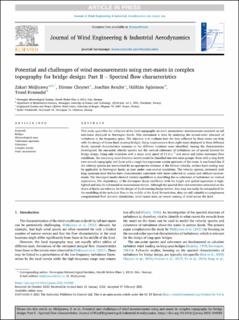| dc.contributor.author | Zakari, Aoudou Midjiyawa | |
| dc.contributor.author | Cheynet, Etienne | |
| dc.contributor.author | Reuder, Joachim | |
| dc.contributor.author | Ágústsson, Hálfdán | |
| dc.contributor.author | Kvamsdal, Trond | |
| dc.date.accessioned | 2021-04-06T14:14:09Z | |
| dc.date.available | 2021-04-06T14:14:09Z | |
| dc.date.created | 2021-04-02T15:37:55Z | |
| dc.date.issued | 2021 | |
| dc.identifier.issn | 0167-6105 | |
| dc.identifier.uri | https://hdl.handle.net/11250/2736441 | |
| dc.description.abstract | This study quantifies the influence of the local topography on sonic anemometer measurements mounted on tall met-masts deployed in Norwegian fjords. This assessment is done by analysing the second-order structure of turbulence in the frequency space. The objective is to evaluate how the data collected by these masts can help with the design of future fjord-crossing bridges. Using measurements from eight masts deployed in three different fjords, spectral characteristics common to the different locations were identified. Among the characteristics investigated, the one-point velocity spectra and the vertical coherence of turbulence are of special interest for bridge design. Using only situations with a mean wind speed of 12 m s−1 and above and rather stationary flow conditions, the remaining wind direction sectors could be classified into two main groups: those with a long fetch over smooth topography and those with a rough heterogeneous terrain upstream of the masts. It was found that if the velocity spectra are normalized by an appropriate estimate of the friction velocity, surface-layer scaling may be applicable in Norwegian fjords, at least under near-neutral conditions. The velocity spectra, estimated with long upstream fjord fetches have characteristics consistent with those collected in coastal and offshore environments. The Davenport model showed limited capabilities in describing the co-coherence of turbulence on vertical separations. The dependency of the Davenport decay coefficient with the height and spatial separation is highlighted and may be substantial in mountainous terrain. Although the spectral flow characteristics estimated on the shore of fjords are relevant for the design of fjord-crossing bridge towers, they may not easily be extrapolated for the modelling of the turbulent flow in the middle of the fjord. Nevertheless, they are still valuable to complement computational fluid dynamic simulations, wind tunnel tests, or remote sensing of wind across the fjord. | en_US |
| dc.language.iso | eng | en_US |
| dc.publisher | Elsevier | en_US |
| dc.rights | Navngivelse 4.0 Internasjonal | * |
| dc.rights.uri | http://creativecommons.org/licenses/by/4.0/deed.no | * |
| dc.title | Potential and challenges of wind measurements using met-masts in complex topography for bridge design: Part II – Spectral flow characteristics | en_US |
| dc.type | Peer reviewed | en_US |
| dc.type | Journal article | en_US |
| dc.description.version | publishedVersion | en_US |
| dc.source.journal | Journal of Wind Engineering and Industrial Aerodynamics | en_US |
| dc.identifier.doi | 10.1016/j.jweia.2021.104585 | |
| dc.identifier.cristin | 1901981 | |
| dc.description.localcode | © 2021 The Author(s). Published by Elsevier Ltd. This is an open access article under the CC BY license (http://creativecommons.org/licenses/by/4.0/). | en_US |
| cristin.ispublished | true | |
| cristin.fulltext | original | |
| cristin.qualitycode | 1 | |

